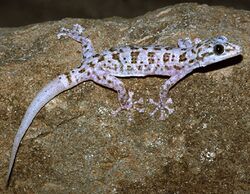Biology:Xantus leaf-toed gecko
| Xantus' leaf-toed gecko | |
|---|---|

| |
| Scientific classification | |
| Domain: | Eukaryota |
| Kingdom: | Animalia |
| Phylum: | Chordata |
| Class: | Reptilia |
| Order: | Squamata |
| Family: | Phyllodactylidae |
| Genus: | Phyllodactylus |
| Species: | P. xanti
|
| Binomial name | |
| Phyllodactylus xanti Cope, 1863[2]
| |
Xantus' leaf-toed gecko, or the leaf-toed gecko (Phyllodactylus xanti ), is a species of New World gecko.
Geographic range
P. xanti is found in California and Mexico.
Description
P. xanti has vertical pupils, immovable eyelids, and leaf-like toe pads. It has a brownish, grey, or pinkish dorsum, with a light venter. The granular dorsal scales are interspersed with tubercles.
It often squeaks when handled, and it has a very fragile tail which is readily lost.
This gecko is between 2.5 and 6.2 cm (1.5 and 2.5 inches) in snout-to-vent length (SVL).
Subspecies
Three subspecies are recognized as being valid, including the nominotypical subspecies.[3]
- Phyllodactylus xanti sloani Bostic, 1971
- Phyllodactylus xanti xanti Cope, 1863
- Phyllodactylus xanti zweifeli Dixon, 1964
Etymology
The common name, Xantus' leaf-toed gecko, and the specific epithet, xanti, commemorate John Xantus,[4] a nineteenth century naturalist active in the United States of America.[5] It is also referred to, ambiguously, as the leaf-toed gecko.
The subspecific names, sloani and zweifeli, are in honor of American herpetologists Allan John Sloan and Richard G. Zweifel, respectively.[5]
Taxonomy
The accepted scientific name and original description were published in 1863 by Edward Drinker Cope.[3]
References
- ↑ Hammerson GA (2007). "Phyllodactylus xanti". The IUCN Red List of Threatened Species (IUCN) 2007: e.T64051A12740152. doi:10.2305/IUCN.UK.2007.RLTS.T64051A12740152.en. http://www.iucnredlist.org/details/64051/0. Retrieved 15 January 2018.
- ↑ "Phyllodactylus xanti Cope, 1863". ITIS (Integrated Taxonomic Information System).
- ↑ 3.0 3.1 Phyllodactylus xanti at the Reptarium.cz Reptile Database.
- ↑ a.k.a. Louis deVesey (1825-1894).
- ↑ 5.0 5.1 Beolens, Bo; Watkins, Michael; Grayson, Michael (2011). The Eponym Dictionary of Reptiles. Baltimore: Johns Hopkins University Press. xiii + 296 pp. ISBN:978-1-4214-0135-5. (Phyllodactylus xanti, p. 291; P. x. sloani, p. 246; P. nocticolus zweifeli, p. 294).
Further reading
- Behler JL, King FW (1979). The Audubon Society Field Guide to North American Reptiles and Amphibians. New York: Alfred A. Knopf. 743 pp. ISBN:0-394-50824-6. (Phyllodactylus xanti, p. 494 + Plate 391).
- Cope ED (1863). "Descriptions of new American SQUAMATA, in the Museum of the Smithsonian Institution, Washington". Proc. Acad. Nat. Sci. Philadelphia 15: 100-106. (Phyllodactylus xanti, new species, pp. 102–103).
- Smith HM, Brodie ED Jr (1982). Reptiles of North America: A Guide to Field Identification. New York: Golden Press. 240 pp. ISBN:0-307-13666-3. (Phyllodactylus xanti, pp. 70–71).
- Stebbins RC (2003). A Field Guide to Western Reptiles and Amphibians, Third Edition. The Peterson Field Guide Series ®. Boston and New York: Houghton Mifflin. xiii + 533 pp. ISBN:978-0-395-98272-3. (Phyllodactylus xanti, p. 266 + Plate 24 + Map 73).
Wikidata ☰ Q3024759 entry


